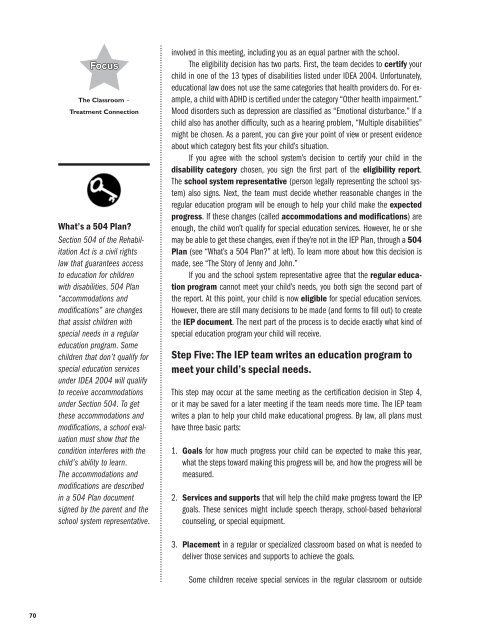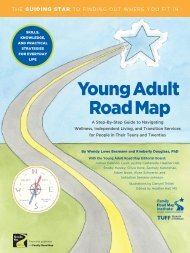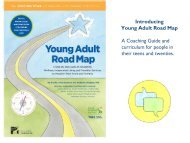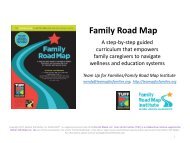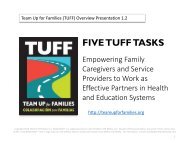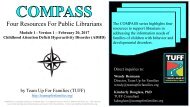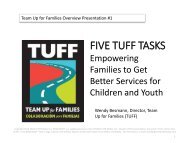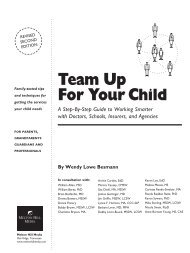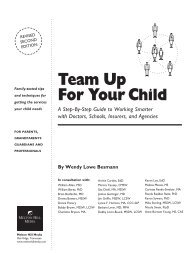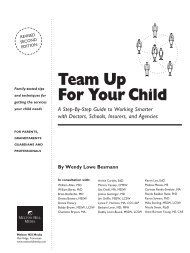Family Road Map Guide
Create successful ePaper yourself
Turn your PDF publications into a flip-book with our unique Google optimized e-Paper software.
Focus<br />
The Classroom –<br />
Treatment Connection<br />
What’s a 504 Plan?<br />
Section 504 of the Rehabilitation<br />
Act is a civil rights<br />
law that guarantees access<br />
to education for children<br />
with disabilities. 504 Plan<br />
“accommodations and<br />
modifications” are changes<br />
that assist children with<br />
special needs in a regular<br />
education program. Some<br />
children that don’t qualify for<br />
special education services<br />
under IDEA 2004 will qualify<br />
to receive accommodations<br />
under Section 504. To get<br />
these accommodations and<br />
modifications, a school evaluation<br />
must show that the<br />
condition interferes with the<br />
child’s ability to learn.<br />
The accommodations and<br />
modifications are described<br />
in a 504 Plan document<br />
signed by the parent and the<br />
school system representative.<br />
involved in this meeting, including you as an equal partner with the school.<br />
The eligibility decision has two parts. First, the team decides to certify your<br />
child in one of the 13 types of disabilities listed under IDEA 2004. Unfortunately,<br />
educational law does not use the same categories that health providers do. For example,<br />
a child with ADHD is certified under the category “Other health impairment.”<br />
Mood disorders such as depression are classified as “Emotional disturbance.” If a<br />
child also has another difficulty, such as a hearing problem, “Multiple disabilities”<br />
might be chosen. As a parent, you can give your point of view or present evidence<br />
about which category best fits your child’s situation.<br />
If you agree with the school system’s decision to certify your child in the<br />
disability category chosen, you sign the first part of the eligibility report.<br />
The school system representative (person legally representing the school system)<br />
also signs. Next, the team must decide whether reasonable changes in the<br />
regular education program will be enough to help your child make the expected<br />
progress. If these changes (called accommodations and modifications) are<br />
enough, the child won’t qualify for special education services. However, he or she<br />
may be able to get these changes, even if they’re not in the IEP Plan, through a 504<br />
Plan (see “What’s a 504 Plan?” at left). To learn more about how this decision is<br />
made, see “The Story of Jenny and John.”<br />
If you and the school system representative agree that the regular education<br />
program cannot meet your child’s needs, you both sign the second part of<br />
the report. At this point, your child is now eligible for special education services.<br />
However, there are still many decisions to be made (and forms to fill out) to create<br />
the IEP document. The next part of the process is to decide exactly what kind of<br />
special education program your child will receive.<br />
Step Five: The IEP team writes an education program to<br />
meet your child’s special needs.<br />
This step may occur at the same meeting as the certification decision in Step 4,<br />
or it may be saved for a later meeting if the team needs more time. The IEP team<br />
writes a plan to help your child make educational progress. By law, all plans must<br />
have three basic parts:<br />
1. Goals for how much progress your child can be expected to make this year,<br />
what the steps toward making this progress will be, and how the progress will be<br />
measured.<br />
2. Services and supports that will help the child make progress toward the IEP<br />
goals. These services might include speech therapy, school-based behavioral<br />
counseling, or special equipment.<br />
3. Placement in a regular or specialized classroom based on what is needed to<br />
deliver those services and supports to achieve the goals.<br />
Some children receive special services in the regular classroom or outside<br />
70


